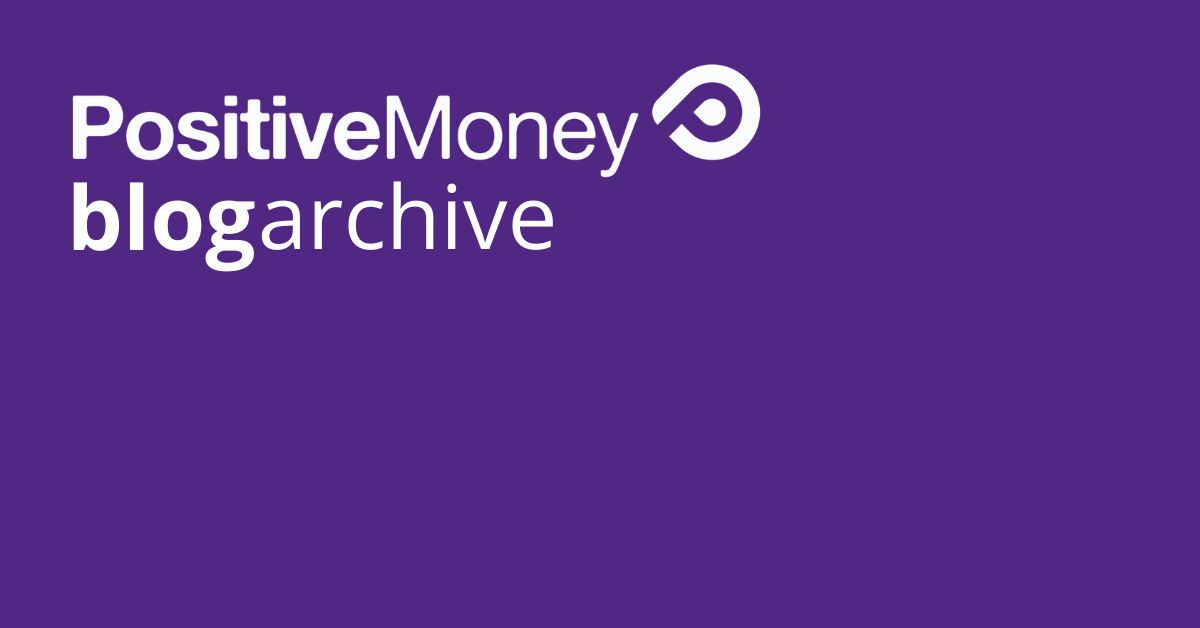From negative to positive: Money without the debt

We need to reform a money system that no longer serves the needs of the public
This article appeared originally on the Sheffield Political Economy Research Institute’s website
It used to be thought that the means of final settlement of payments had to possess intrinsic value. Since the means of exchange had to be physically limited in supply in order to possess intrinsic value, methods had to be devised to economise on their use and distribution. This is how banks came to be charged in the first place with the task of accumulating stocks of the medium of exchange and using these for settlement of payments on behalf of their customers.
But today’s world economy no longer relies on a medium of exchange to settle payments. The reality is that payments no longer involve the exchange of value for value received, or even the promise of value, since currency no longer possesses intrinsic value.
What do I mean? Payments today are settled with state-issued means of payment, not with a medium of exchange. But banks still monopolise the means of payment as if they were scarce resources whose use had to be optimised. Commerce still depends upon the banks to settle from their own resources the payments that their customers wish to make, and the whole world economy is thus hostage to the liquidity of banks. This was of course demonstrated to devastating effect in the global financial crisis of 2007-8 and beyond.
Banks have evolved an elaborate, expensive and failure-prone mechanism to sustain this liquidity. They do so through the system of inter-bank borrowing buttressed by the role of the central bank, which acts as a lender of last resort. Authorities have implemented elaborate, expensive and ineffective regulatory systems in an attempt to reduce the risk of failure, warn of impending disaster and minimise the damage.
Yet none of this is necessary! There is no physical limit on the availability of the state-issued means of payment as there must be on an intrinsically valuable medium of exchange, like gold for example. There is no reason, whether on the grounds of efficiency or prudence, why those who have earned or otherwise legitimately acquired the ability to make payments should not hold the state-issued means of payment directly, rather than merely via the promises of banks.
The fractional reserve banking system with its administrative and regulatory overheads was designed for a world which no longer exists and actually which hasn’t existed since 1971 when then US President Richard Nixon uncoupled the US dollar from gold and states consequently abandoned the Bretton Woods system of fixed exchange rates.
Until then there were indeed constraints on the ability of sovereign states to issue their own currency – at a fixed exchange rate against the dollar – which were imposed by the need for stocks of physical gold to back the dollar. Since then, although those constraints have been lifted, the central banks of sovereign states have failed to take the lead and instead left it to private enterprise banks to issue their own currency by expanding their balance sheets. This is a technical mechanism which simply means creating new deposits, namely, promises by the bank (the bank’s liabilities) to make payments on the deposit holder’s behalf, in exchange for new loans (the bank’s assets), these in turn being promises by the deposit holder to make payments to the bank equal to those promised by the bank, plus interest. In effect, the money the economy needs to function can only be obtained by taking on debt.
The reform that is appropriate for today’s world is not more regulation of the balance sheets of banks, but rather removal from the banks, to the payers themselves, of the means for final settlement of the payments they make. And that is the reform proposed by Joseph Huber and James Robertson and subsequently developed by Huber through Monetative in Germany and separately by Positive Money in the UK, and by similar organisations in Switzerland, Ireland, New Zealand, the USA, Israel and the Netherlands.
Under the Positive Money version, for example, a person’s current account will constitute a legal claim on a fund held at the Bank of England, say, for the purpose of settling payments, and a payment by that person will consist of the transfer of that claim to the payment recipient via a payments systems operated, as at present, by that person’s bank. The Bank of England fund will contain one pound for every pound that is entitled to be spent, whether or not the entitled owner intends to spend it now, sometime, or never. There will be no daily scramble, as at present, to ensure that banks have sufficient funds available for spending to settle the amounts that customers wish to spend. Every customer has their own fund from which their spending is financed. The banks operate therefore only as agents of their customers in administering the accounts and the payments system.
In short, the primary responsibility of banks will no longer be to ensure that they have sufficient liquidity to settle customers’ payments, but to persuade customers, who in the near future do not intend to make all of the payments to which they are entitled, to make their unused money available for lending to others instead.
Isn’t that what we thought banks did all along?